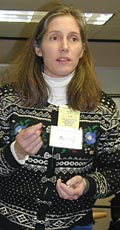Are you ready for producers' questions about the scrapie program?
 Veterinarians are central to the success of the accelerated scrapie eradication program launched by the Department of Agriculture last year. Yet, Dr. Marie S. Bulgin, who works with producers, believes many veterinarians are unfamiliar with the program. Dr. Bulgin, a University of Idaho veterinary professor who represents the American Association of Small Ruminant Practitioners on the USDA National Scrapie Oversight Committee, told JAVMA that she has been receiving calls from veterinarians after producers ask them for guidance. What's more, the NAHMS Sheep 2001 Study found that feedlots were far more likely to go to their veterinarians than to other sources for advice. According to Dr. Katherine L. Marshall, veterinary epidemiologist with the USDA-APHIS-VS Centers for Epidemiology and Animal Health, 39 percent of the producers surveyed considered veterinarians an important source of information. Next important were other producers and shearers. Only 19 percent of those surveyed thought the Internet an important source of information. The goal is to eliminate scrapie by 2010 and have the United States declared scrapie free by 2017. International standards require seven years without a scrapie outbreak for a country to be recognized as free. All 50 states have agreed to abide by the accelerated program, in which the USDA has established the following two key requirements. First, most breeding animals and all sheep 18 months of age and older must be officially identified to be moved in interstate commerce. Second, states must meet minimal standards for state scrapie control to move breeding sheep and goats freely, interstate. All breeding sheep, certain breeding goats, and sexually intact sheep and goats for exhibition crossing state lines must be identified and must be accompanied by an official Certificate of Veterinary Inspection issued by an accredited veterinarian. Those entering interstate commerce must also be identified.  Sheep and goats currently enrolled in the Voluntary Scrapie Flock Certification Program will not require new identification before they change ownership and/or enter into interstate commerce. The eradication program does not supersede the Voluntary Scrapie Flock Certification Program. Instead, the certification program gives participants a head start on the eradication program. The voluntary certification program is a cooperative effort among producers, allied industry representatives, accredited veterinarians, state animal health officials, and the USDA-APHIS. As of Feb. 28, 2002, the certification program had 1,010 participating flocks. The final rule in the eradication program sets the standards for effective state scrapie control programs and lists states that meet the standards. A Consistent State must require reporting of scrapie suspects and must quarantine infected and source flocks. Some states have, or are in the process of setting up, procedures unique to their circumstances but consistent with the federal program. Veterinarians can find these additional state regulations at the state veterinarian's office. Every time Dr. Cindy Wolf writes a veterinary certificate for the program, she consults such regulations. A small ruminant specialist at the University of Minnesota, Dr. Wolf is involved in the national scrapie education initiative being coordinated by the National Institute for Animal Agriculture. The final rule reinstates an indemnity program for certain sheep and goats affected by scrapie. The amount is based on market price plus a premium for purebred animals, to discourage fraud, according to Dr. Diane L. Sutton, national scrapie program coordinator. The interstate movement final rule was published Aug. 21, 2001. The compliance date was Sept. 20 for movement of exposed animals and most consistent state requirements; Nov. 19, for most identification requirements; and Feb. 19, 2002, for breeding whiteface sheep under 18 months of age.
According to the NIAA, producers will find their veterinarian an important partner in the scrapie program. The NIAA has been sending veterinarians across the nation detailed instruction in all aspects of the program, including identification procedures, shipping requirements, and procedures for reporting outbreaks. The eradication program relies on veterinarians to educate their clients and to report the disease to state and federal officials when they suspect it. When requested by producers, veterinarians can apply official ear tags, issue Certificatesof Veterinary Inspection for interstate movement, and assist in developing and completing flock clean up plans. Veterinarians must maintain a record of animals they tag for five years. Dr. Cindy Wolf said, "This summer is going to be a real test as [sheep] shows come on, as to whether everybody understands how the regulations work." The features of the eradication program that the USDA is staking its confidence for success on are:
The purpose of identifying sheep and goats is not only to trace back scrapie-positive animals to their flock or herd of origin, but also to trace out—or forward—animals from infected and source flocks, something industry doesn't always recognize. Already, the USDA is considering nearly 20 possible changes to the regulations governing the scrapie eradication program. Most are aimed at streamlining the record keeping from farm to market. Others relate to definitions. Dr. Wolf noted, "As we tweak the rules, we need to present clear, consistent messages so people don't lose faith in the program." The agency is accepting input on these changes as well as suggestions on other concerns until the proposed changes are published for comment in the Federal Register. Requests for a description of the currently proposed changes and your comments on them should be sent via e-mail to Dr. Diane L. Sutton, diane [dot] l [dot] sutton | ||
 Dr. Cindy Wolf
Dr. Cindy Wolf
